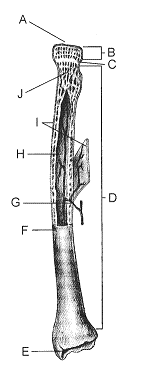In studying T cell proliferation (cell division) in response to a specific antigen, you decide to stimulate these T cells with antigen and examine the genes that are activated by the interaction. To do this, following stimulation you should isolate
A) DNA.
B) rRNA.
C) mRNA.
D) tRNA.
E) plasmid DNA.
C) mRNA.
You might also like to view...
The pecking behavior in young herring gulls is triggered primarily by a red spot on the bill of the parent, and is
performed repeatedly in the same way; therefore, it is an example of ____
a. imprinting b. a learned response c. a fixed action pattern d. operant conditioning e. classical conditioning
Amniocentesis cannot be used to detect fetal
A) gender. B) intelligence. C) chromosomal abnormalities. D) biochemicals that indicate an inborn error of metabolism.
The portion of the bone labeled B in Figure 40-3 is called:

a. the periosteum.
b. the diaphysis.
c. the epiphysis.
d. compact bone.
e. metaphysis.
Releases hormones that control blood sugar levels by stimulating glycogen formation or breakdown
(A) testis (B) Lining of small intestine (C) Anterior pituitary (D) thyroid (E) pancreas